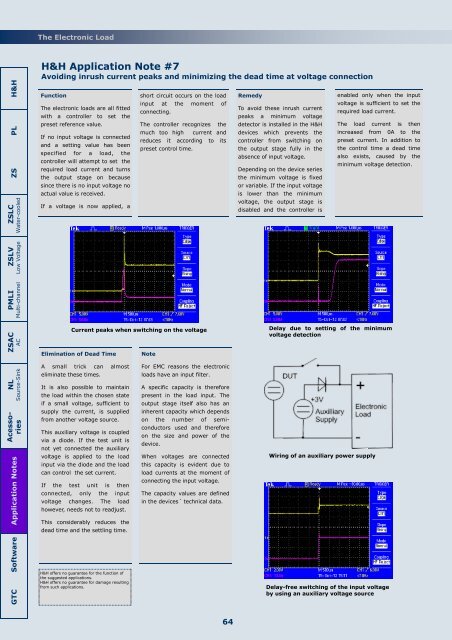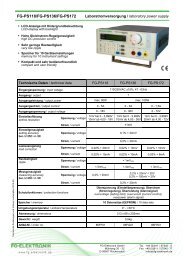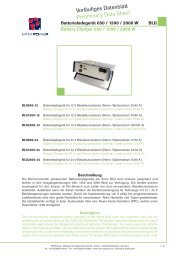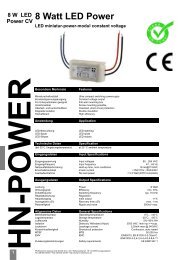The Electronic Load
The Electronic Load
The Electronic Load
You also want an ePaper? Increase the reach of your titles
YUMPU automatically turns print PDFs into web optimized ePapers that Google loves.
<strong>The</strong> <strong>Electronic</strong> <strong>Load</strong><br />
Application Notes ZS PL H&H<br />
ZSLC<br />
Water-cooled<br />
ZSLV<br />
Low Voltage<br />
PMLI<br />
Multi-channel<br />
ZSAC<br />
AC<br />
NL<br />
Source-Sink<br />
Acessories<br />
H&H Application Note #7<br />
Avoiding inrush current peaks and minimizing the dead time at voltage connection<br />
Function<br />
<strong>The</strong> electronic loads are all fitted<br />
with a controller to set the<br />
preset reference value.<br />
If no input voltage is connected<br />
and a setting value has been<br />
specified for a load, the<br />
controller will attempt to set the<br />
required load current and turns<br />
the output stage on because<br />
since there is no input voltage no<br />
actual value is received.<br />
If a voltage is now applied, a<br />
Elimination of Dead Time<br />
A small trick can almost<br />
eliminate these times.<br />
It is also possible to maintain<br />
the load within the chosen state<br />
if a small voltage, sufficient to<br />
supply the current, is supplied<br />
from another voltage source.<br />
This auxiliary voltage is coupled<br />
via a diode. If the test unit is<br />
not yet connected the auxiliary<br />
voltage is applied to the load<br />
input via the diode and the load<br />
can control the set current.<br />
If the test unit is then<br />
connected, only the input<br />
voltage changes. <strong>The</strong> load<br />
however, needs not to readjust.<br />
This considerably reduces the<br />
dead time and the settling time.<br />
short circuit occurs on the load<br />
input at the moment of<br />
connecting.<br />
<strong>The</strong> controller recognizes the<br />
much too high current and<br />
reduces it according to its<br />
preset control time.<br />
Current peaks when switching on the voltage<br />
Note<br />
For EMC reasons the electronic<br />
loads have an input filter.<br />
A specific capacity is therefore<br />
present in the load input. <strong>The</strong><br />
output stage itself also has an<br />
inherent capacity which depends<br />
on the number of semiconductors<br />
used and therefore<br />
on the size and power of the<br />
device.<br />
When voltages are connected<br />
this capacity is evident due to<br />
load currents at the moment of<br />
connecting the input voltage.<br />
<strong>The</strong> capacity values are defined<br />
in the devices´ technical data.<br />
Remedy<br />
To avoid these inrush current<br />
peaks a minimum voltage<br />
detector is installed in the H&H<br />
devices which prevents the<br />
controller from switching on<br />
the output stage fully in the<br />
absence of input voltage.<br />
Depending on the device series<br />
the minimum voltage is fixed<br />
or variable. If the input voltage<br />
is lower than the minimum<br />
voltage, the output stage is<br />
disabled and the controller is<br />
enabled only when the input<br />
voltage is sufficient to set the<br />
required load current.<br />
<strong>The</strong> load current is then<br />
increased from 0A to the<br />
preset current. In addition to<br />
the control time a dead time<br />
also exists, caused by the<br />
minimum voltage detection.<br />
Delay due to setting of the minimum<br />
voltage detection<br />
Wiring of an auxiliary power supply<br />
Software<br />
GTC<br />
H&H offers no guarantee for the function of<br />
the suggested applications.<br />
H&H offers no guarantee for damage resulting<br />
from such applications.<br />
Delay-free switching of the input voltage<br />
by using an auxiliary voltage source<br />
64








